Intervention Strategies for Double Burden of Malnutrition in SA
VerifiedAdded on 2023/06/03
|13
|4044
|151
Essay
AI Summary
This essay discusses intervention strategies to address the double burden of malnutrition in South Africa, where undernutrition and overnutrition coexist. It highlights the shift from traditional food systems to westernized diets as a significant driver of this issue. The essay suggests preserving traditional food systems by encouraging local production, processing, and consumption of culturally accepted foods. It emphasizes that the double burden affects individuals across their life course, particularly in rapidly developing countries. The determinants are categorized into economic/food environment, physical/built environment, health/biological environment, and socio/cultural environment factors. The essay also explores the etiology and epidemiology of malnutrition, differentiating between undernutrition and overnutrition. It provides global statistics on both conditions and discusses the dire consequences of early life undernutrition and overnutrition. The South Africa’s food production capacity and dietary patterns are examined, noting the transition towards protein-filled diets. The essay concludes that solving South Africa’s dual burden requires strategies that meet current and future nutritional needs, particularly by embracing traditional food crops and processing methods.
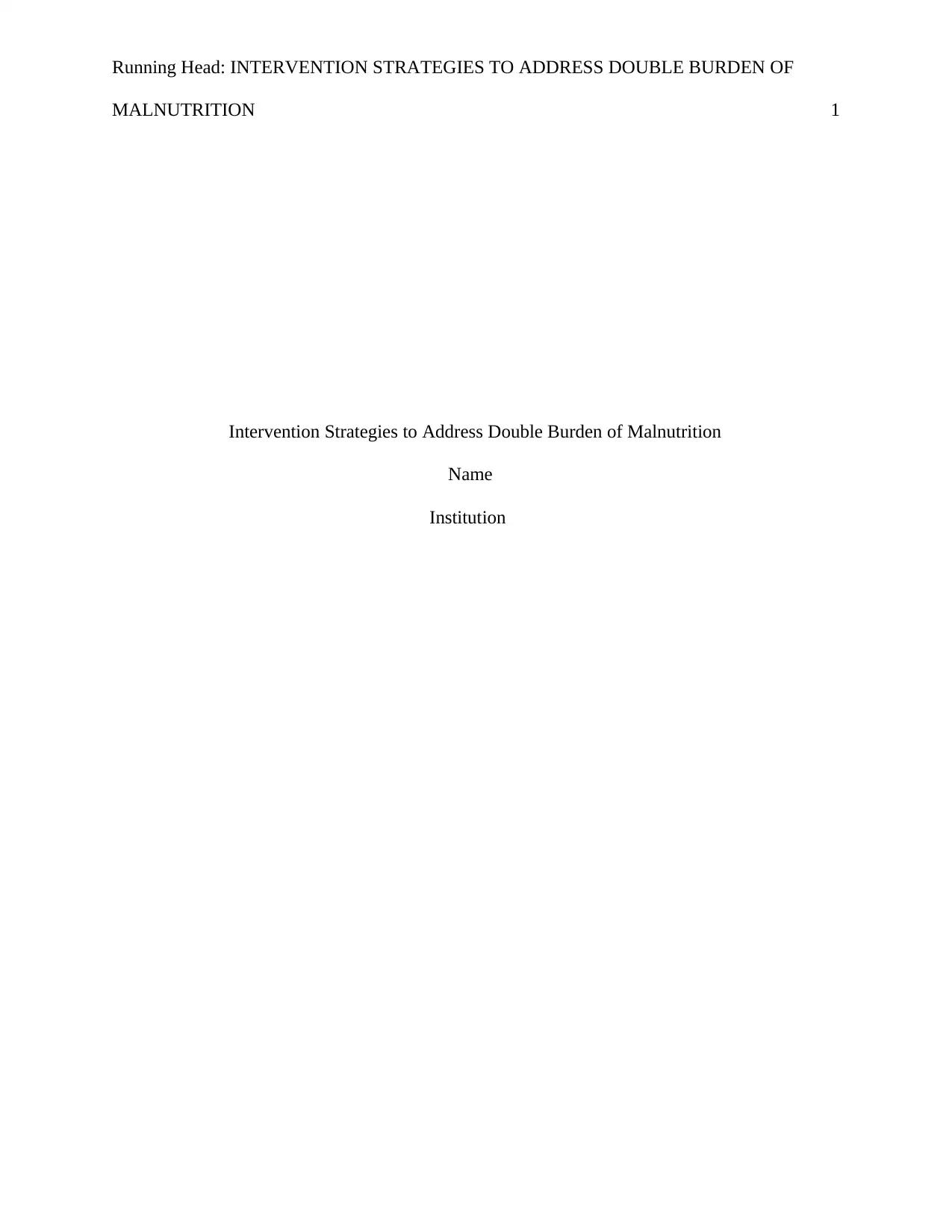
Running Head: INTERVENTION STRATEGIES TO ADDRESS DOUBLE BURDEN OF
MALNUTRITION 1
Intervention Strategies to Address Double Burden of Malnutrition
Name
Institution
MALNUTRITION 1
Intervention Strategies to Address Double Burden of Malnutrition
Name
Institution
Paraphrase This Document
Need a fresh take? Get an instant paraphrase of this document with our AI Paraphraser
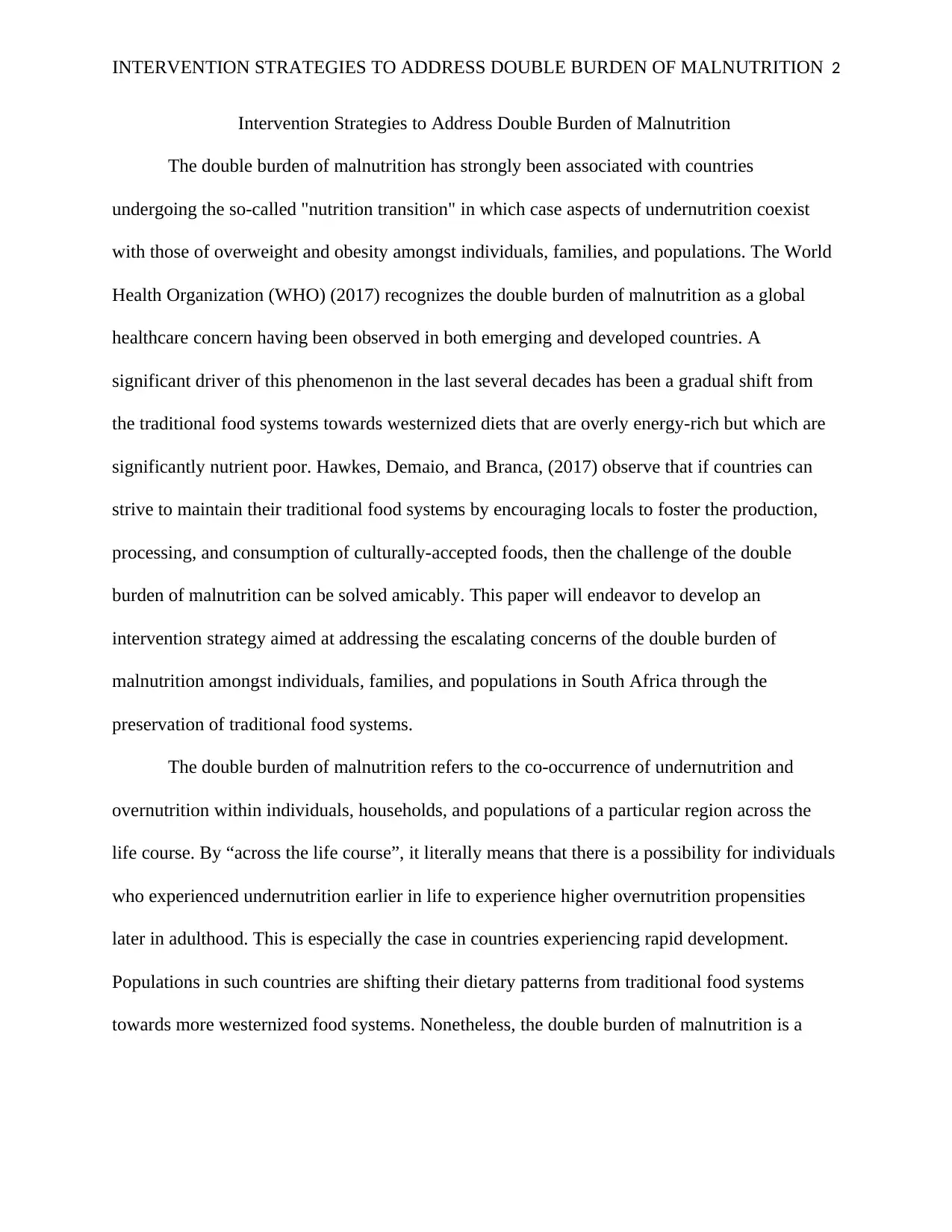
INTERVENTION STRATEGIES TO ADDRESS DOUBLE BURDEN OF MALNUTRITION 2
Intervention Strategies to Address Double Burden of Malnutrition
The double burden of malnutrition has strongly been associated with countries
undergoing the so-called "nutrition transition" in which case aspects of undernutrition coexist
with those of overweight and obesity amongst individuals, families, and populations. The World
Health Organization (WHO) (2017) recognizes the double burden of malnutrition as a global
healthcare concern having been observed in both emerging and developed countries. A
significant driver of this phenomenon in the last several decades has been a gradual shift from
the traditional food systems towards westernized diets that are overly energy-rich but which are
significantly nutrient poor. Hawkes, Demaio, and Branca, (2017) observe that if countries can
strive to maintain their traditional food systems by encouraging locals to foster the production,
processing, and consumption of culturally-accepted foods, then the challenge of the double
burden of malnutrition can be solved amicably. This paper will endeavor to develop an
intervention strategy aimed at addressing the escalating concerns of the double burden of
malnutrition amongst individuals, families, and populations in South Africa through the
preservation of traditional food systems.
The double burden of malnutrition refers to the co-occurrence of undernutrition and
overnutrition within individuals, households, and populations of a particular region across the
life course. By “across the life course”, it literally means that there is a possibility for individuals
who experienced undernutrition earlier in life to experience higher overnutrition propensities
later in adulthood. This is especially the case in countries experiencing rapid development.
Populations in such countries are shifting their dietary patterns from traditional food systems
towards more westernized food systems. Nonetheless, the double burden of malnutrition is a
Intervention Strategies to Address Double Burden of Malnutrition
The double burden of malnutrition has strongly been associated with countries
undergoing the so-called "nutrition transition" in which case aspects of undernutrition coexist
with those of overweight and obesity amongst individuals, families, and populations. The World
Health Organization (WHO) (2017) recognizes the double burden of malnutrition as a global
healthcare concern having been observed in both emerging and developed countries. A
significant driver of this phenomenon in the last several decades has been a gradual shift from
the traditional food systems towards westernized diets that are overly energy-rich but which are
significantly nutrient poor. Hawkes, Demaio, and Branca, (2017) observe that if countries can
strive to maintain their traditional food systems by encouraging locals to foster the production,
processing, and consumption of culturally-accepted foods, then the challenge of the double
burden of malnutrition can be solved amicably. This paper will endeavor to develop an
intervention strategy aimed at addressing the escalating concerns of the double burden of
malnutrition amongst individuals, families, and populations in South Africa through the
preservation of traditional food systems.
The double burden of malnutrition refers to the co-occurrence of undernutrition and
overnutrition within individuals, households, and populations of a particular region across the
life course. By “across the life course”, it literally means that there is a possibility for individuals
who experienced undernutrition earlier in life to experience higher overnutrition propensities
later in adulthood. This is especially the case in countries experiencing rapid development.
Populations in such countries are shifting their dietary patterns from traditional food systems
towards more westernized food systems. Nonetheless, the double burden of malnutrition is a
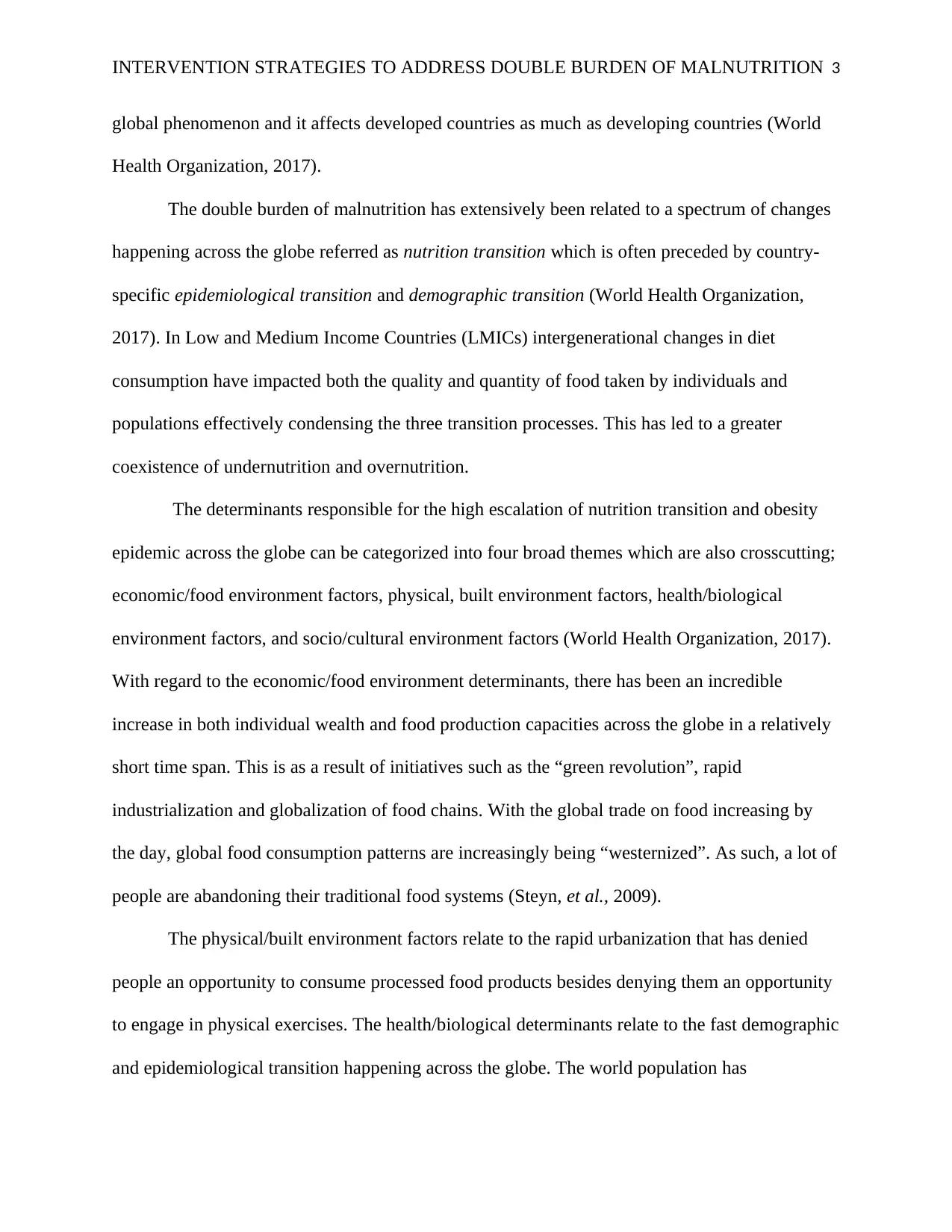
INTERVENTION STRATEGIES TO ADDRESS DOUBLE BURDEN OF MALNUTRITION 3
global phenomenon and it affects developed countries as much as developing countries (World
Health Organization, 2017).
The double burden of malnutrition has extensively been related to a spectrum of changes
happening across the globe referred as nutrition transition which is often preceded by country-
specific epidemiological transition and demographic transition (World Health Organization,
2017). In Low and Medium Income Countries (LMICs) intergenerational changes in diet
consumption have impacted both the quality and quantity of food taken by individuals and
populations effectively condensing the three transition processes. This has led to a greater
coexistence of undernutrition and overnutrition.
The determinants responsible for the high escalation of nutrition transition and obesity
epidemic across the globe can be categorized into four broad themes which are also crosscutting;
economic/food environment factors, physical, built environment factors, health/biological
environment factors, and socio/cultural environment factors (World Health Organization, 2017).
With regard to the economic/food environment determinants, there has been an incredible
increase in both individual wealth and food production capacities across the globe in a relatively
short time span. This is as a result of initiatives such as the “green revolution”, rapid
industrialization and globalization of food chains. With the global trade on food increasing by
the day, global food consumption patterns are increasingly being “westernized”. As such, a lot of
people are abandoning their traditional food systems (Steyn, et al., 2009).
The physical/built environment factors relate to the rapid urbanization that has denied
people an opportunity to consume processed food products besides denying them an opportunity
to engage in physical exercises. The health/biological determinants relate to the fast demographic
and epidemiological transition happening across the globe. The world population has
global phenomenon and it affects developed countries as much as developing countries (World
Health Organization, 2017).
The double burden of malnutrition has extensively been related to a spectrum of changes
happening across the globe referred as nutrition transition which is often preceded by country-
specific epidemiological transition and demographic transition (World Health Organization,
2017). In Low and Medium Income Countries (LMICs) intergenerational changes in diet
consumption have impacted both the quality and quantity of food taken by individuals and
populations effectively condensing the three transition processes. This has led to a greater
coexistence of undernutrition and overnutrition.
The determinants responsible for the high escalation of nutrition transition and obesity
epidemic across the globe can be categorized into four broad themes which are also crosscutting;
economic/food environment factors, physical, built environment factors, health/biological
environment factors, and socio/cultural environment factors (World Health Organization, 2017).
With regard to the economic/food environment determinants, there has been an incredible
increase in both individual wealth and food production capacities across the globe in a relatively
short time span. This is as a result of initiatives such as the “green revolution”, rapid
industrialization and globalization of food chains. With the global trade on food increasing by
the day, global food consumption patterns are increasingly being “westernized”. As such, a lot of
people are abandoning their traditional food systems (Steyn, et al., 2009).
The physical/built environment factors relate to the rapid urbanization that has denied
people an opportunity to consume processed food products besides denying them an opportunity
to engage in physical exercises. The health/biological determinants relate to the fast demographic
and epidemiological transition happening across the globe. The world population has
⊘ This is a preview!⊘
Do you want full access?
Subscribe today to unlock all pages.

Trusted by 1+ million students worldwide
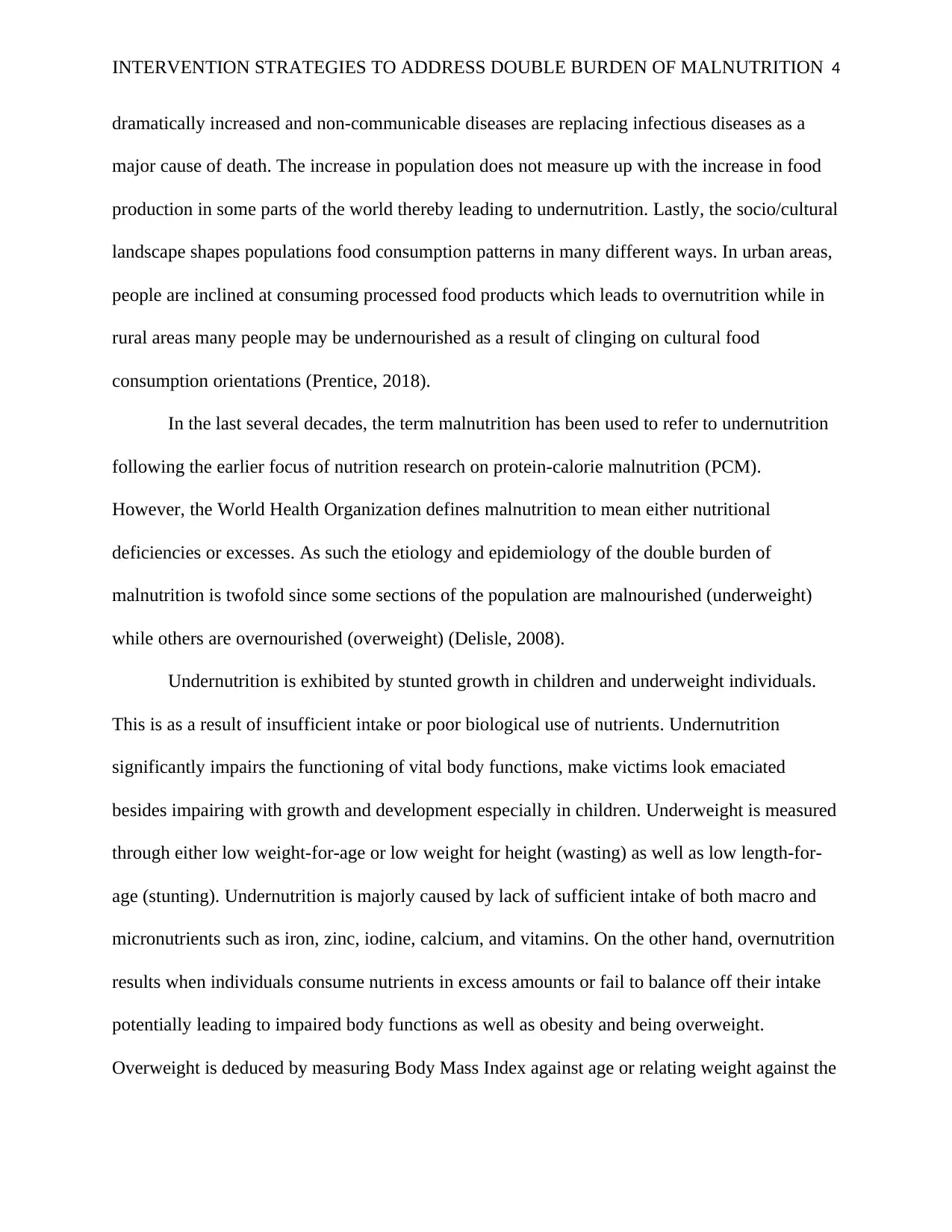
INTERVENTION STRATEGIES TO ADDRESS DOUBLE BURDEN OF MALNUTRITION 4
dramatically increased and non-communicable diseases are replacing infectious diseases as a
major cause of death. The increase in population does not measure up with the increase in food
production in some parts of the world thereby leading to undernutrition. Lastly, the socio/cultural
landscape shapes populations food consumption patterns in many different ways. In urban areas,
people are inclined at consuming processed food products which leads to overnutrition while in
rural areas many people may be undernourished as a result of clinging on cultural food
consumption orientations (Prentice, 2018).
In the last several decades, the term malnutrition has been used to refer to undernutrition
following the earlier focus of nutrition research on protein-calorie malnutrition (PCM).
However, the World Health Organization defines malnutrition to mean either nutritional
deficiencies or excesses. As such the etiology and epidemiology of the double burden of
malnutrition is twofold since some sections of the population are malnourished (underweight)
while others are overnourished (overweight) (Delisle, 2008).
Undernutrition is exhibited by stunted growth in children and underweight individuals.
This is as a result of insufficient intake or poor biological use of nutrients. Undernutrition
significantly impairs the functioning of vital body functions, make victims look emaciated
besides impairing with growth and development especially in children. Underweight is measured
through either low weight-for-age or low weight for height (wasting) as well as low length-for-
age (stunting). Undernutrition is majorly caused by lack of sufficient intake of both macro and
micronutrients such as iron, zinc, iodine, calcium, and vitamins. On the other hand, overnutrition
results when individuals consume nutrients in excess amounts or fail to balance off their intake
potentially leading to impaired body functions as well as obesity and being overweight.
Overweight is deduced by measuring Body Mass Index against age or relating weight against the
dramatically increased and non-communicable diseases are replacing infectious diseases as a
major cause of death. The increase in population does not measure up with the increase in food
production in some parts of the world thereby leading to undernutrition. Lastly, the socio/cultural
landscape shapes populations food consumption patterns in many different ways. In urban areas,
people are inclined at consuming processed food products which leads to overnutrition while in
rural areas many people may be undernourished as a result of clinging on cultural food
consumption orientations (Prentice, 2018).
In the last several decades, the term malnutrition has been used to refer to undernutrition
following the earlier focus of nutrition research on protein-calorie malnutrition (PCM).
However, the World Health Organization defines malnutrition to mean either nutritional
deficiencies or excesses. As such the etiology and epidemiology of the double burden of
malnutrition is twofold since some sections of the population are malnourished (underweight)
while others are overnourished (overweight) (Delisle, 2008).
Undernutrition is exhibited by stunted growth in children and underweight individuals.
This is as a result of insufficient intake or poor biological use of nutrients. Undernutrition
significantly impairs the functioning of vital body functions, make victims look emaciated
besides impairing with growth and development especially in children. Underweight is measured
through either low weight-for-age or low weight for height (wasting) as well as low length-for-
age (stunting). Undernutrition is majorly caused by lack of sufficient intake of both macro and
micronutrients such as iron, zinc, iodine, calcium, and vitamins. On the other hand, overnutrition
results when individuals consume nutrients in excess amounts or fail to balance off their intake
potentially leading to impaired body functions as well as obesity and being overweight.
Overweight is deduced by measuring Body Mass Index against age or relating weight against the
Paraphrase This Document
Need a fresh take? Get an instant paraphrase of this document with our AI Paraphraser
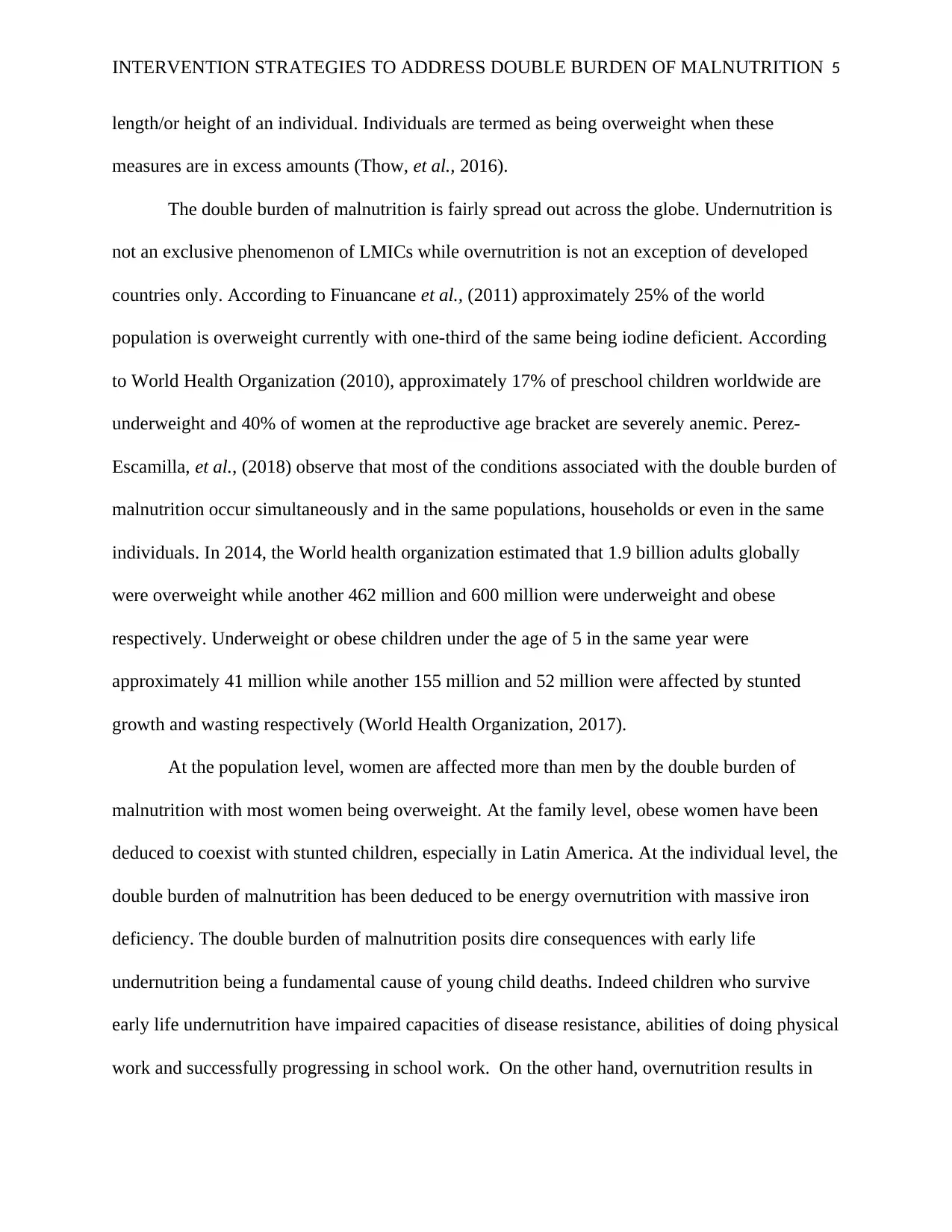
INTERVENTION STRATEGIES TO ADDRESS DOUBLE BURDEN OF MALNUTRITION 5
length/or height of an individual. Individuals are termed as being overweight when these
measures are in excess amounts (Thow, et al., 2016).
The double burden of malnutrition is fairly spread out across the globe. Undernutrition is
not an exclusive phenomenon of LMICs while overnutrition is not an exception of developed
countries only. According to Finuancane et al., (2011) approximately 25% of the world
population is overweight currently with one-third of the same being iodine deficient. According
to World Health Organization (2010), approximately 17% of preschool children worldwide are
underweight and 40% of women at the reproductive age bracket are severely anemic. Perez-
Escamilla, et al., (2018) observe that most of the conditions associated with the double burden of
malnutrition occur simultaneously and in the same populations, households or even in the same
individuals. In 2014, the World health organization estimated that 1.9 billion adults globally
were overweight while another 462 million and 600 million were underweight and obese
respectively. Underweight or obese children under the age of 5 in the same year were
approximately 41 million while another 155 million and 52 million were affected by stunted
growth and wasting respectively (World Health Organization, 2017).
At the population level, women are affected more than men by the double burden of
malnutrition with most women being overweight. At the family level, obese women have been
deduced to coexist with stunted children, especially in Latin America. At the individual level, the
double burden of malnutrition has been deduced to be energy overnutrition with massive iron
deficiency. The double burden of malnutrition posits dire consequences with early life
undernutrition being a fundamental cause of young child deaths. Indeed children who survive
early life undernutrition have impaired capacities of disease resistance, abilities of doing physical
work and successfully progressing in school work. On the other hand, overnutrition results in
length/or height of an individual. Individuals are termed as being overweight when these
measures are in excess amounts (Thow, et al., 2016).
The double burden of malnutrition is fairly spread out across the globe. Undernutrition is
not an exclusive phenomenon of LMICs while overnutrition is not an exception of developed
countries only. According to Finuancane et al., (2011) approximately 25% of the world
population is overweight currently with one-third of the same being iodine deficient. According
to World Health Organization (2010), approximately 17% of preschool children worldwide are
underweight and 40% of women at the reproductive age bracket are severely anemic. Perez-
Escamilla, et al., (2018) observe that most of the conditions associated with the double burden of
malnutrition occur simultaneously and in the same populations, households or even in the same
individuals. In 2014, the World health organization estimated that 1.9 billion adults globally
were overweight while another 462 million and 600 million were underweight and obese
respectively. Underweight or obese children under the age of 5 in the same year were
approximately 41 million while another 155 million and 52 million were affected by stunted
growth and wasting respectively (World Health Organization, 2017).
At the population level, women are affected more than men by the double burden of
malnutrition with most women being overweight. At the family level, obese women have been
deduced to coexist with stunted children, especially in Latin America. At the individual level, the
double burden of malnutrition has been deduced to be energy overnutrition with massive iron
deficiency. The double burden of malnutrition posits dire consequences with early life
undernutrition being a fundamental cause of young child deaths. Indeed children who survive
early life undernutrition have impaired capacities of disease resistance, abilities of doing physical
work and successfully progressing in school work. On the other hand, overnutrition results in
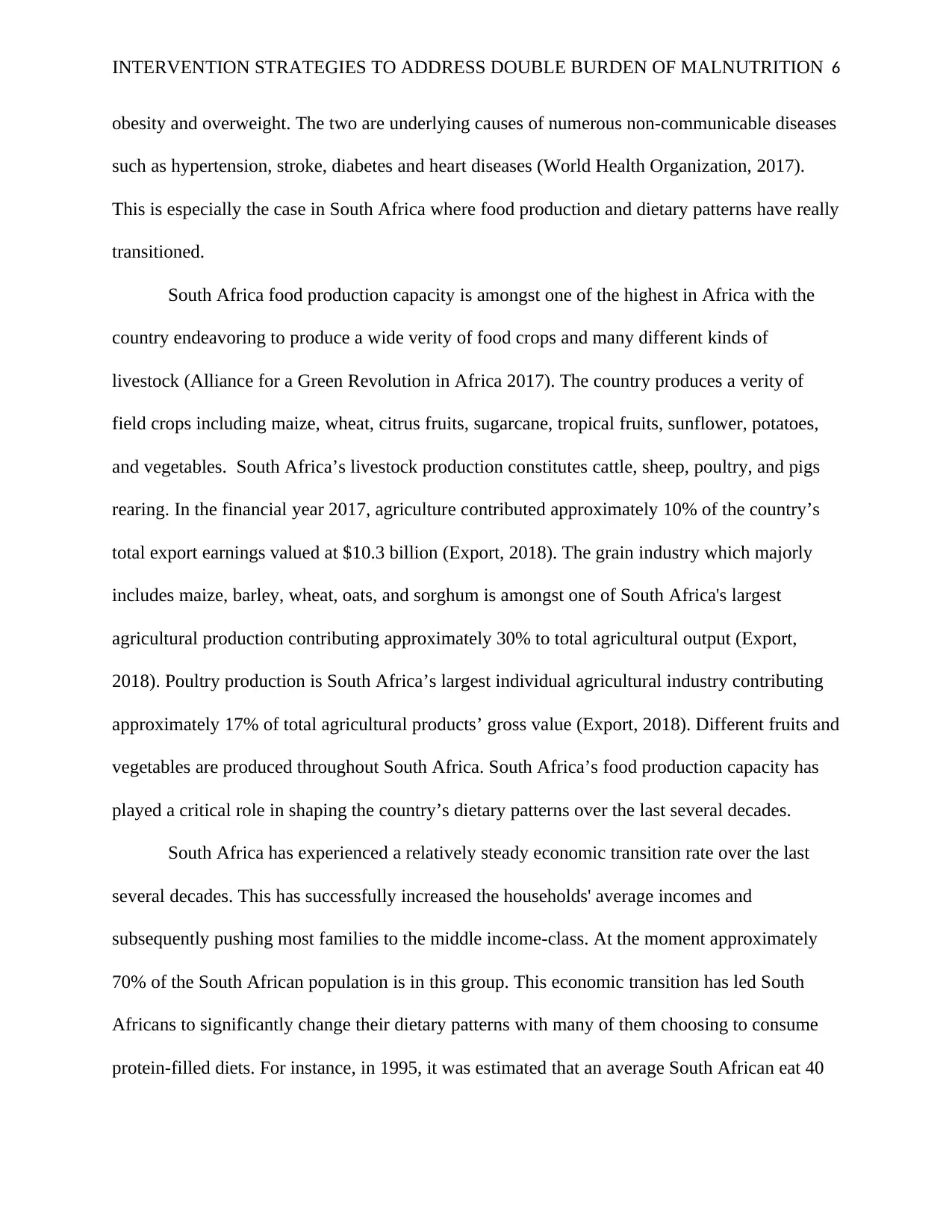
INTERVENTION STRATEGIES TO ADDRESS DOUBLE BURDEN OF MALNUTRITION 6
obesity and overweight. The two are underlying causes of numerous non-communicable diseases
such as hypertension, stroke, diabetes and heart diseases (World Health Organization, 2017).
This is especially the case in South Africa where food production and dietary patterns have really
transitioned.
South Africa food production capacity is amongst one of the highest in Africa with the
country endeavoring to produce a wide verity of food crops and many different kinds of
livestock (Alliance for a Green Revolution in Africa 2017). The country produces a verity of
field crops including maize, wheat, citrus fruits, sugarcane, tropical fruits, sunflower, potatoes,
and vegetables. South Africa’s livestock production constitutes cattle, sheep, poultry, and pigs
rearing. In the financial year 2017, agriculture contributed approximately 10% of the country’s
total export earnings valued at $10.3 billion (Export, 2018). The grain industry which majorly
includes maize, barley, wheat, oats, and sorghum is amongst one of South Africa's largest
agricultural production contributing approximately 30% to total agricultural output (Export,
2018). Poultry production is South Africa’s largest individual agricultural industry contributing
approximately 17% of total agricultural products’ gross value (Export, 2018). Different fruits and
vegetables are produced throughout South Africa. South Africa’s food production capacity has
played a critical role in shaping the country’s dietary patterns over the last several decades.
South Africa has experienced a relatively steady economic transition rate over the last
several decades. This has successfully increased the households' average incomes and
subsequently pushing most families to the middle income-class. At the moment approximately
70% of the South African population is in this group. This economic transition has led South
Africans to significantly change their dietary patterns with many of them choosing to consume
protein-filled diets. For instance, in 1995, it was estimated that an average South African eat 40
obesity and overweight. The two are underlying causes of numerous non-communicable diseases
such as hypertension, stroke, diabetes and heart diseases (World Health Organization, 2017).
This is especially the case in South Africa where food production and dietary patterns have really
transitioned.
South Africa food production capacity is amongst one of the highest in Africa with the
country endeavoring to produce a wide verity of food crops and many different kinds of
livestock (Alliance for a Green Revolution in Africa 2017). The country produces a verity of
field crops including maize, wheat, citrus fruits, sugarcane, tropical fruits, sunflower, potatoes,
and vegetables. South Africa’s livestock production constitutes cattle, sheep, poultry, and pigs
rearing. In the financial year 2017, agriculture contributed approximately 10% of the country’s
total export earnings valued at $10.3 billion (Export, 2018). The grain industry which majorly
includes maize, barley, wheat, oats, and sorghum is amongst one of South Africa's largest
agricultural production contributing approximately 30% to total agricultural output (Export,
2018). Poultry production is South Africa’s largest individual agricultural industry contributing
approximately 17% of total agricultural products’ gross value (Export, 2018). Different fruits and
vegetables are produced throughout South Africa. South Africa’s food production capacity has
played a critical role in shaping the country’s dietary patterns over the last several decades.
South Africa has experienced a relatively steady economic transition rate over the last
several decades. This has successfully increased the households' average incomes and
subsequently pushing most families to the middle income-class. At the moment approximately
70% of the South African population is in this group. This economic transition has led South
Africans to significantly change their dietary patterns with many of them choosing to consume
protein-filled diets. For instance, in 1995, it was estimated that an average South African eat 40
⊘ This is a preview!⊘
Do you want full access?
Subscribe today to unlock all pages.

Trusted by 1+ million students worldwide
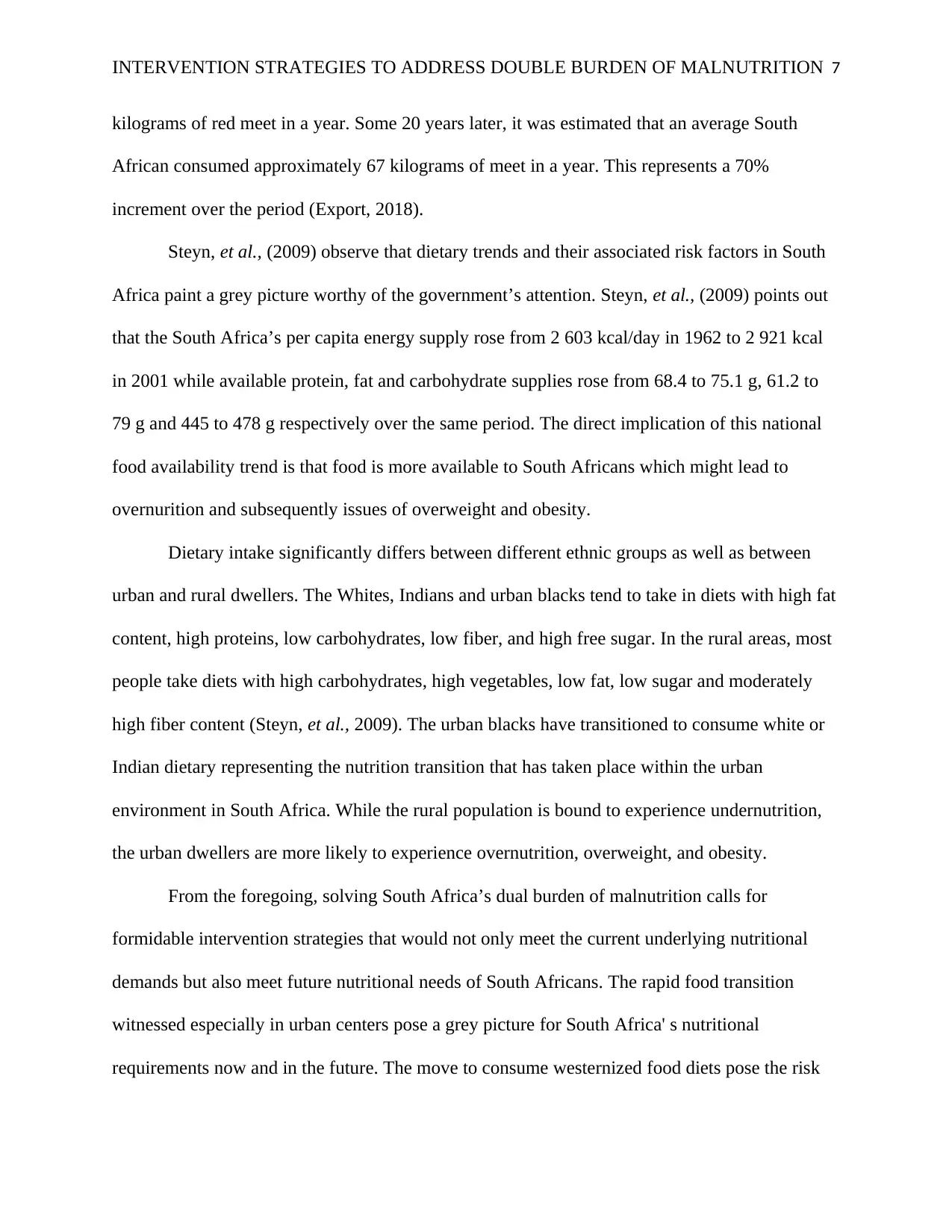
INTERVENTION STRATEGIES TO ADDRESS DOUBLE BURDEN OF MALNUTRITION 7
kilograms of red meet in a year. Some 20 years later, it was estimated that an average South
African consumed approximately 67 kilograms of meet in a year. This represents a 70%
increment over the period (Export, 2018).
Steyn, et al., (2009) observe that dietary trends and their associated risk factors in South
Africa paint a grey picture worthy of the government’s attention. Steyn, et al., (2009) points out
that the South Africa’s per capita energy supply rose from 2 603 kcal/day in 1962 to 2 921 kcal
in 2001 while available protein, fat and carbohydrate supplies rose from 68.4 to 75.1 g, 61.2 to
79 g and 445 to 478 g respectively over the same period. The direct implication of this national
food availability trend is that food is more available to South Africans which might lead to
overnurition and subsequently issues of overweight and obesity.
Dietary intake significantly differs between different ethnic groups as well as between
urban and rural dwellers. The Whites, Indians and urban blacks tend to take in diets with high fat
content, high proteins, low carbohydrates, low fiber, and high free sugar. In the rural areas, most
people take diets with high carbohydrates, high vegetables, low fat, low sugar and moderately
high fiber content (Steyn, et al., 2009). The urban blacks have transitioned to consume white or
Indian dietary representing the nutrition transition that has taken place within the urban
environment in South Africa. While the rural population is bound to experience undernutrition,
the urban dwellers are more likely to experience overnutrition, overweight, and obesity.
From the foregoing, solving South Africa’s dual burden of malnutrition calls for
formidable intervention strategies that would not only meet the current underlying nutritional
demands but also meet future nutritional needs of South Africans. The rapid food transition
witnessed especially in urban centers pose a grey picture for South Africa' s nutritional
requirements now and in the future. The move to consume westernized food diets pose the risk
kilograms of red meet in a year. Some 20 years later, it was estimated that an average South
African consumed approximately 67 kilograms of meet in a year. This represents a 70%
increment over the period (Export, 2018).
Steyn, et al., (2009) observe that dietary trends and their associated risk factors in South
Africa paint a grey picture worthy of the government’s attention. Steyn, et al., (2009) points out
that the South Africa’s per capita energy supply rose from 2 603 kcal/day in 1962 to 2 921 kcal
in 2001 while available protein, fat and carbohydrate supplies rose from 68.4 to 75.1 g, 61.2 to
79 g and 445 to 478 g respectively over the same period. The direct implication of this national
food availability trend is that food is more available to South Africans which might lead to
overnurition and subsequently issues of overweight and obesity.
Dietary intake significantly differs between different ethnic groups as well as between
urban and rural dwellers. The Whites, Indians and urban blacks tend to take in diets with high fat
content, high proteins, low carbohydrates, low fiber, and high free sugar. In the rural areas, most
people take diets with high carbohydrates, high vegetables, low fat, low sugar and moderately
high fiber content (Steyn, et al., 2009). The urban blacks have transitioned to consume white or
Indian dietary representing the nutrition transition that has taken place within the urban
environment in South Africa. While the rural population is bound to experience undernutrition,
the urban dwellers are more likely to experience overnutrition, overweight, and obesity.
From the foregoing, solving South Africa’s dual burden of malnutrition calls for
formidable intervention strategies that would not only meet the current underlying nutritional
demands but also meet future nutritional needs of South Africans. The rapid food transition
witnessed especially in urban centers pose a grey picture for South Africa' s nutritional
requirements now and in the future. The move to consume westernized food diets pose the risk
Paraphrase This Document
Need a fresh take? Get an instant paraphrase of this document with our AI Paraphraser
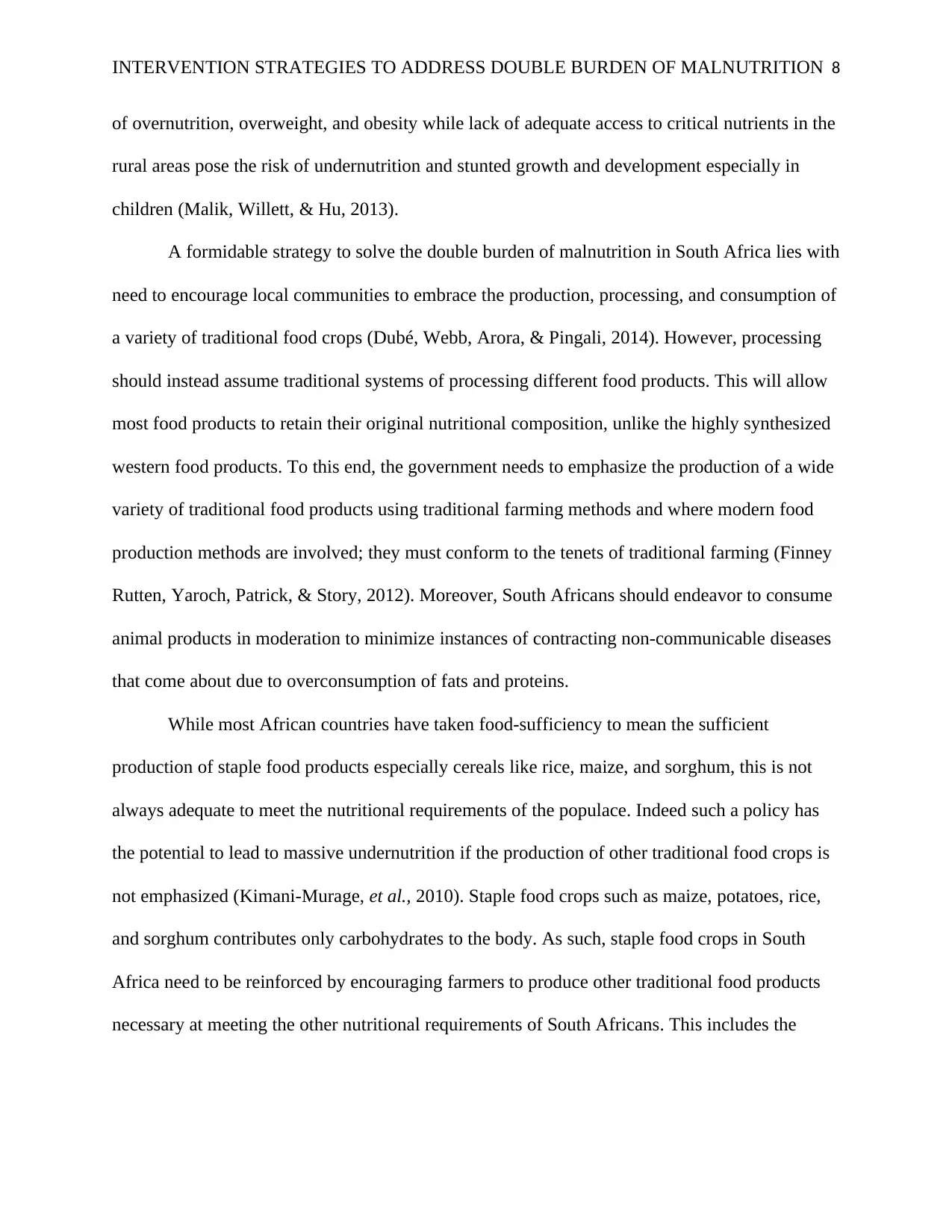
INTERVENTION STRATEGIES TO ADDRESS DOUBLE BURDEN OF MALNUTRITION 8
of overnutrition, overweight, and obesity while lack of adequate access to critical nutrients in the
rural areas pose the risk of undernutrition and stunted growth and development especially in
children (Malik, Willett, & Hu, 2013).
A formidable strategy to solve the double burden of malnutrition in South Africa lies with
need to encourage local communities to embrace the production, processing, and consumption of
a variety of traditional food crops (Dubé, Webb, Arora, & Pingali, 2014). However, processing
should instead assume traditional systems of processing different food products. This will allow
most food products to retain their original nutritional composition, unlike the highly synthesized
western food products. To this end, the government needs to emphasize the production of a wide
variety of traditional food products using traditional farming methods and where modern food
production methods are involved; they must conform to the tenets of traditional farming (Finney
Rutten, Yaroch, Patrick, & Story, 2012). Moreover, South Africans should endeavor to consume
animal products in moderation to minimize instances of contracting non-communicable diseases
that come about due to overconsumption of fats and proteins.
While most African countries have taken food-sufficiency to mean the sufficient
production of staple food products especially cereals like rice, maize, and sorghum, this is not
always adequate to meet the nutritional requirements of the populace. Indeed such a policy has
the potential to lead to massive undernutrition if the production of other traditional food crops is
not emphasized (Kimani-Murage, et al., 2010). Staple food crops such as maize, potatoes, rice,
and sorghum contributes only carbohydrates to the body. As such, staple food crops in South
Africa need to be reinforced by encouraging farmers to produce other traditional food products
necessary at meeting the other nutritional requirements of South Africans. This includes the
of overnutrition, overweight, and obesity while lack of adequate access to critical nutrients in the
rural areas pose the risk of undernutrition and stunted growth and development especially in
children (Malik, Willett, & Hu, 2013).
A formidable strategy to solve the double burden of malnutrition in South Africa lies with
need to encourage local communities to embrace the production, processing, and consumption of
a variety of traditional food crops (Dubé, Webb, Arora, & Pingali, 2014). However, processing
should instead assume traditional systems of processing different food products. This will allow
most food products to retain their original nutritional composition, unlike the highly synthesized
western food products. To this end, the government needs to emphasize the production of a wide
variety of traditional food products using traditional farming methods and where modern food
production methods are involved; they must conform to the tenets of traditional farming (Finney
Rutten, Yaroch, Patrick, & Story, 2012). Moreover, South Africans should endeavor to consume
animal products in moderation to minimize instances of contracting non-communicable diseases
that come about due to overconsumption of fats and proteins.
While most African countries have taken food-sufficiency to mean the sufficient
production of staple food products especially cereals like rice, maize, and sorghum, this is not
always adequate to meet the nutritional requirements of the populace. Indeed such a policy has
the potential to lead to massive undernutrition if the production of other traditional food crops is
not emphasized (Kimani-Murage, et al., 2010). Staple food crops such as maize, potatoes, rice,
and sorghum contributes only carbohydrates to the body. As such, staple food crops in South
Africa need to be reinforced by encouraging farmers to produce other traditional food products
necessary at meeting the other nutritional requirements of South Africans. This includes the
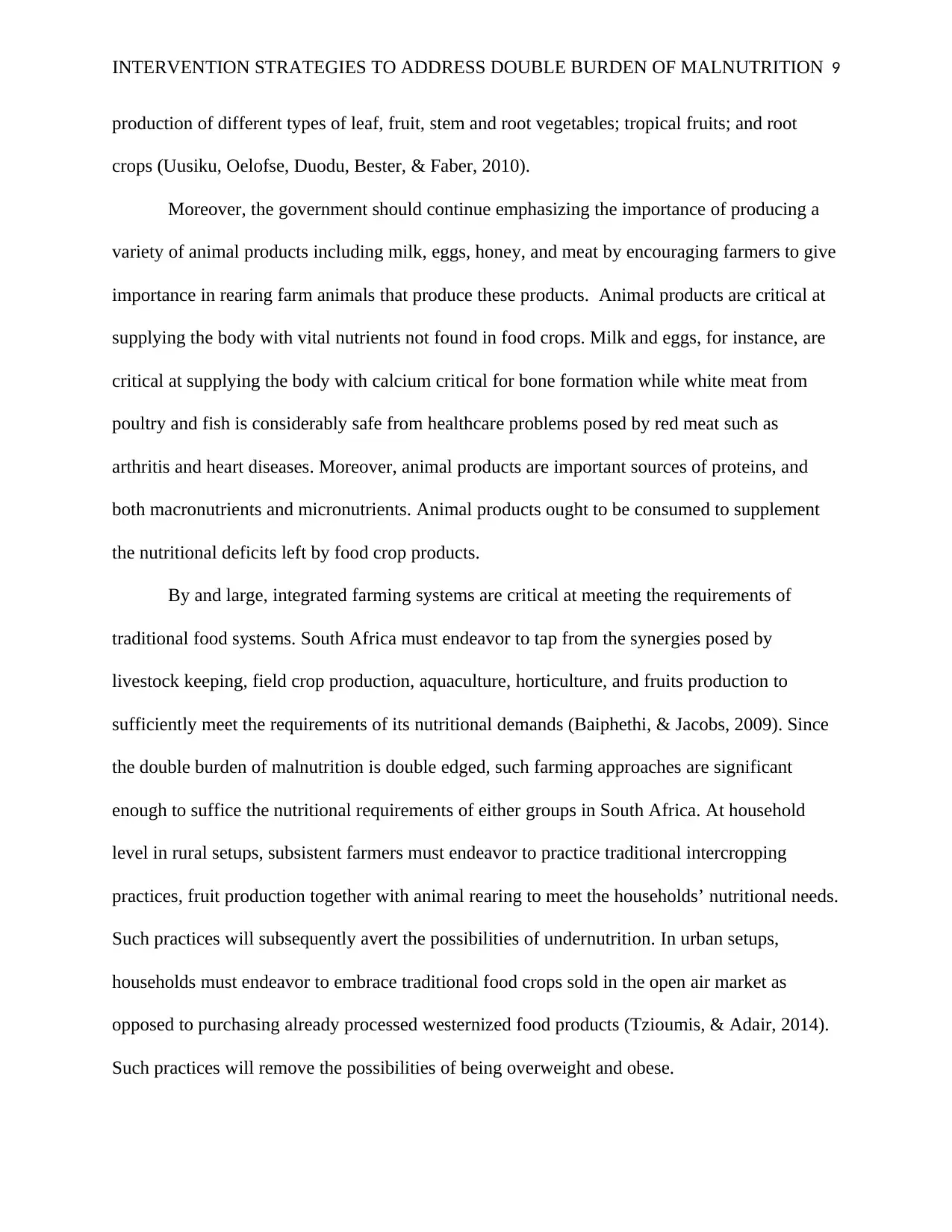
INTERVENTION STRATEGIES TO ADDRESS DOUBLE BURDEN OF MALNUTRITION 9
production of different types of leaf, fruit, stem and root vegetables; tropical fruits; and root
crops (Uusiku, Oelofse, Duodu, Bester, & Faber, 2010).
Moreover, the government should continue emphasizing the importance of producing a
variety of animal products including milk, eggs, honey, and meat by encouraging farmers to give
importance in rearing farm animals that produce these products. Animal products are critical at
supplying the body with vital nutrients not found in food crops. Milk and eggs, for instance, are
critical at supplying the body with calcium critical for bone formation while white meat from
poultry and fish is considerably safe from healthcare problems posed by red meat such as
arthritis and heart diseases. Moreover, animal products are important sources of proteins, and
both macronutrients and micronutrients. Animal products ought to be consumed to supplement
the nutritional deficits left by food crop products.
By and large, integrated farming systems are critical at meeting the requirements of
traditional food systems. South Africa must endeavor to tap from the synergies posed by
livestock keeping, field crop production, aquaculture, horticulture, and fruits production to
sufficiently meet the requirements of its nutritional demands (Baiphethi, & Jacobs, 2009). Since
the double burden of malnutrition is double edged, such farming approaches are significant
enough to suffice the nutritional requirements of either groups in South Africa. At household
level in rural setups, subsistent farmers must endeavor to practice traditional intercropping
practices, fruit production together with animal rearing to meet the households’ nutritional needs.
Such practices will subsequently avert the possibilities of undernutrition. In urban setups,
households must endeavor to embrace traditional food crops sold in the open air market as
opposed to purchasing already processed westernized food products (Tzioumis, & Adair, 2014).
Such practices will remove the possibilities of being overweight and obese.
production of different types of leaf, fruit, stem and root vegetables; tropical fruits; and root
crops (Uusiku, Oelofse, Duodu, Bester, & Faber, 2010).
Moreover, the government should continue emphasizing the importance of producing a
variety of animal products including milk, eggs, honey, and meat by encouraging farmers to give
importance in rearing farm animals that produce these products. Animal products are critical at
supplying the body with vital nutrients not found in food crops. Milk and eggs, for instance, are
critical at supplying the body with calcium critical for bone formation while white meat from
poultry and fish is considerably safe from healthcare problems posed by red meat such as
arthritis and heart diseases. Moreover, animal products are important sources of proteins, and
both macronutrients and micronutrients. Animal products ought to be consumed to supplement
the nutritional deficits left by food crop products.
By and large, integrated farming systems are critical at meeting the requirements of
traditional food systems. South Africa must endeavor to tap from the synergies posed by
livestock keeping, field crop production, aquaculture, horticulture, and fruits production to
sufficiently meet the requirements of its nutritional demands (Baiphethi, & Jacobs, 2009). Since
the double burden of malnutrition is double edged, such farming approaches are significant
enough to suffice the nutritional requirements of either groups in South Africa. At household
level in rural setups, subsistent farmers must endeavor to practice traditional intercropping
practices, fruit production together with animal rearing to meet the households’ nutritional needs.
Such practices will subsequently avert the possibilities of undernutrition. In urban setups,
households must endeavor to embrace traditional food crops sold in the open air market as
opposed to purchasing already processed westernized food products (Tzioumis, & Adair, 2014).
Such practices will remove the possibilities of being overweight and obese.
⊘ This is a preview!⊘
Do you want full access?
Subscribe today to unlock all pages.

Trusted by 1+ million students worldwide
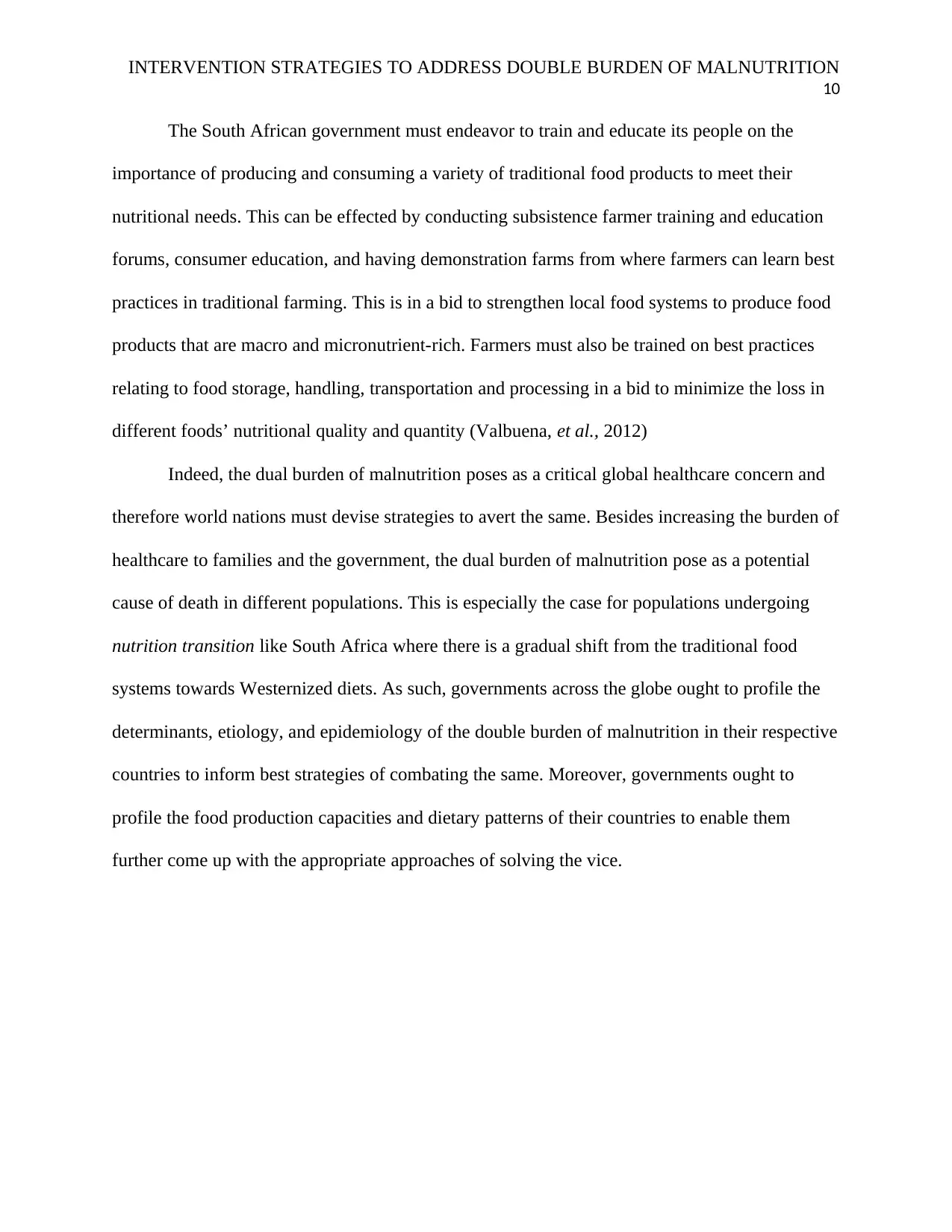
INTERVENTION STRATEGIES TO ADDRESS DOUBLE BURDEN OF MALNUTRITION
10
The South African government must endeavor to train and educate its people on the
importance of producing and consuming a variety of traditional food products to meet their
nutritional needs. This can be effected by conducting subsistence farmer training and education
forums, consumer education, and having demonstration farms from where farmers can learn best
practices in traditional farming. This is in a bid to strengthen local food systems to produce food
products that are macro and micronutrient-rich. Farmers must also be trained on best practices
relating to food storage, handling, transportation and processing in a bid to minimize the loss in
different foods’ nutritional quality and quantity (Valbuena, et al., 2012)
Indeed, the dual burden of malnutrition poses as a critical global healthcare concern and
therefore world nations must devise strategies to avert the same. Besides increasing the burden of
healthcare to families and the government, the dual burden of malnutrition pose as a potential
cause of death in different populations. This is especially the case for populations undergoing
nutrition transition like South Africa where there is a gradual shift from the traditional food
systems towards Westernized diets. As such, governments across the globe ought to profile the
determinants, etiology, and epidemiology of the double burden of malnutrition in their respective
countries to inform best strategies of combating the same. Moreover, governments ought to
profile the food production capacities and dietary patterns of their countries to enable them
further come up with the appropriate approaches of solving the vice.
10
The South African government must endeavor to train and educate its people on the
importance of producing and consuming a variety of traditional food products to meet their
nutritional needs. This can be effected by conducting subsistence farmer training and education
forums, consumer education, and having demonstration farms from where farmers can learn best
practices in traditional farming. This is in a bid to strengthen local food systems to produce food
products that are macro and micronutrient-rich. Farmers must also be trained on best practices
relating to food storage, handling, transportation and processing in a bid to minimize the loss in
different foods’ nutritional quality and quantity (Valbuena, et al., 2012)
Indeed, the dual burden of malnutrition poses as a critical global healthcare concern and
therefore world nations must devise strategies to avert the same. Besides increasing the burden of
healthcare to families and the government, the dual burden of malnutrition pose as a potential
cause of death in different populations. This is especially the case for populations undergoing
nutrition transition like South Africa where there is a gradual shift from the traditional food
systems towards Westernized diets. As such, governments across the globe ought to profile the
determinants, etiology, and epidemiology of the double burden of malnutrition in their respective
countries to inform best strategies of combating the same. Moreover, governments ought to
profile the food production capacities and dietary patterns of their countries to enable them
further come up with the appropriate approaches of solving the vice.
Paraphrase This Document
Need a fresh take? Get an instant paraphrase of this document with our AI Paraphraser
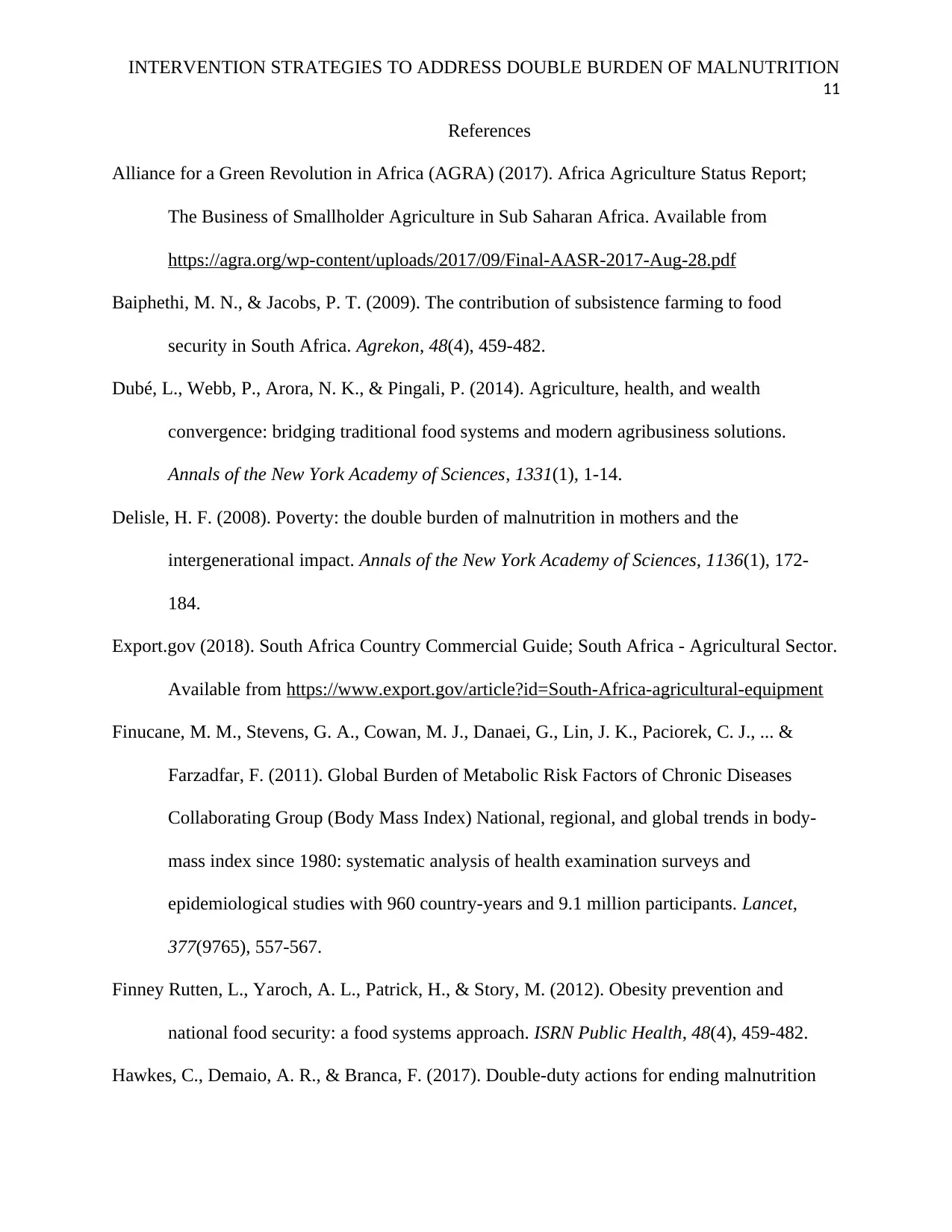
INTERVENTION STRATEGIES TO ADDRESS DOUBLE BURDEN OF MALNUTRITION
11
References
Alliance for a Green Revolution in Africa (AGRA) (2017). Africa Agriculture Status Report;
The Business of Smallholder Agriculture in Sub Saharan Africa. Available from
https://agra.org/wp-content/uploads/2017/09/Final-AASR-2017-Aug-28.pdf
Baiphethi, M. N., & Jacobs, P. T. (2009). The contribution of subsistence farming to food
security in South Africa. Agrekon, 48(4), 459-482.
Dubé, L., Webb, P., Arora, N. K., & Pingali, P. (2014). Agriculture, health, and wealth
convergence: bridging traditional food systems and modern agribusiness solutions.
Annals of the New York Academy of Sciences, 1331(1), 1-14.
Delisle, H. F. (2008). Poverty: the double burden of malnutrition in mothers and the
intergenerational impact. Annals of the New York Academy of Sciences, 1136(1), 172-
184.
Export.gov (2018). South Africa Country Commercial Guide; South Africa - Agricultural Sector.
Available from https://www.export.gov/article?id=South-Africa-agricultural-equipment
Finucane, M. M., Stevens, G. A., Cowan, M. J., Danaei, G., Lin, J. K., Paciorek, C. J., ... &
Farzadfar, F. (2011). Global Burden of Metabolic Risk Factors of Chronic Diseases
Collaborating Group (Body Mass Index) National, regional, and global trends in body-
mass index since 1980: systematic analysis of health examination surveys and
epidemiological studies with 960 country-years and 9.1 million participants. Lancet,
377(9765), 557-567.
Finney Rutten, L., Yaroch, A. L., Patrick, H., & Story, M. (2012). Obesity prevention and
national food security: a food systems approach. ISRN Public Health, 48(4), 459-482.
Hawkes, C., Demaio, A. R., & Branca, F. (2017). Double-duty actions for ending malnutrition
11
References
Alliance for a Green Revolution in Africa (AGRA) (2017). Africa Agriculture Status Report;
The Business of Smallholder Agriculture in Sub Saharan Africa. Available from
https://agra.org/wp-content/uploads/2017/09/Final-AASR-2017-Aug-28.pdf
Baiphethi, M. N., & Jacobs, P. T. (2009). The contribution of subsistence farming to food
security in South Africa. Agrekon, 48(4), 459-482.
Dubé, L., Webb, P., Arora, N. K., & Pingali, P. (2014). Agriculture, health, and wealth
convergence: bridging traditional food systems and modern agribusiness solutions.
Annals of the New York Academy of Sciences, 1331(1), 1-14.
Delisle, H. F. (2008). Poverty: the double burden of malnutrition in mothers and the
intergenerational impact. Annals of the New York Academy of Sciences, 1136(1), 172-
184.
Export.gov (2018). South Africa Country Commercial Guide; South Africa - Agricultural Sector.
Available from https://www.export.gov/article?id=South-Africa-agricultural-equipment
Finucane, M. M., Stevens, G. A., Cowan, M. J., Danaei, G., Lin, J. K., Paciorek, C. J., ... &
Farzadfar, F. (2011). Global Burden of Metabolic Risk Factors of Chronic Diseases
Collaborating Group (Body Mass Index) National, regional, and global trends in body-
mass index since 1980: systematic analysis of health examination surveys and
epidemiological studies with 960 country-years and 9.1 million participants. Lancet,
377(9765), 557-567.
Finney Rutten, L., Yaroch, A. L., Patrick, H., & Story, M. (2012). Obesity prevention and
national food security: a food systems approach. ISRN Public Health, 48(4), 459-482.
Hawkes, C., Demaio, A. R., & Branca, F. (2017). Double-duty actions for ending malnutrition
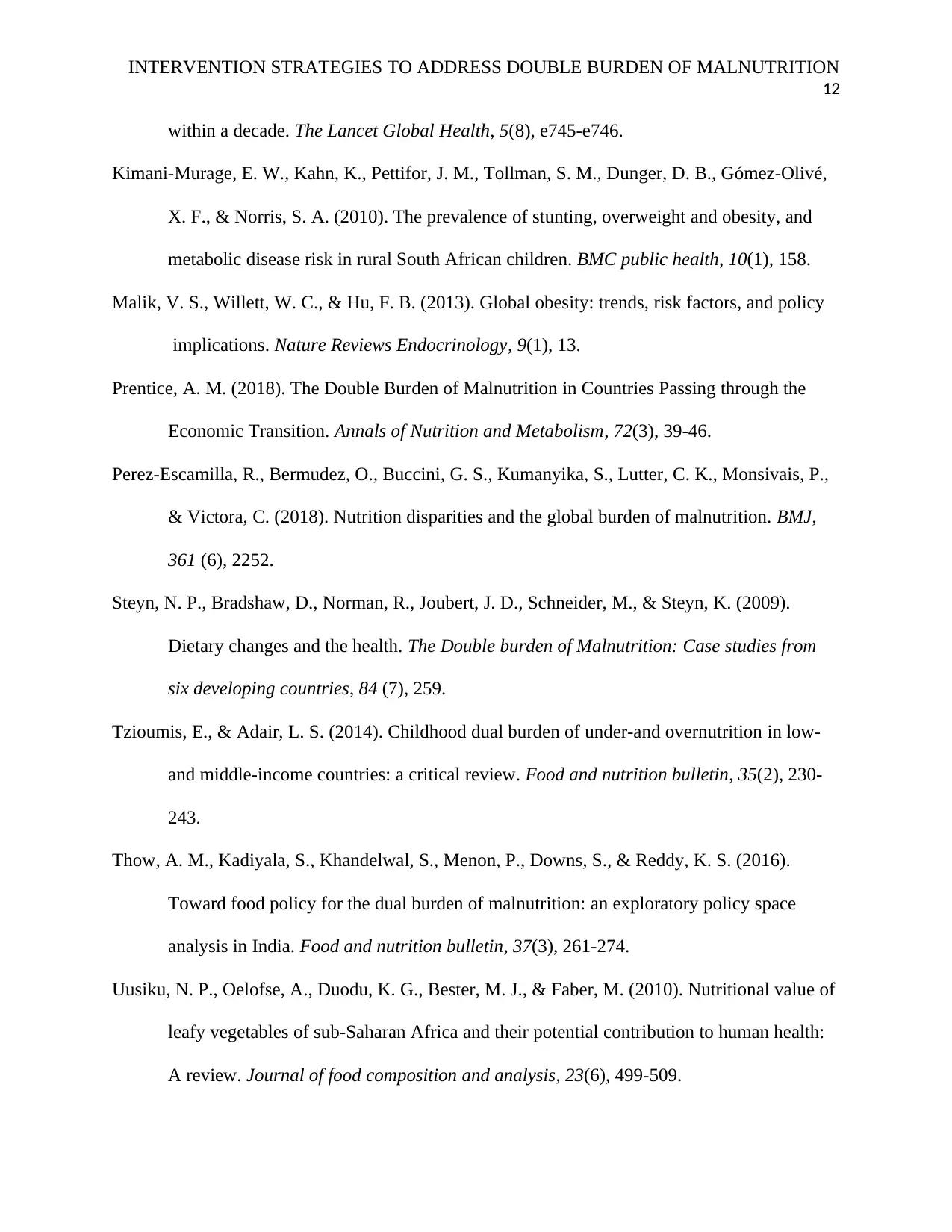
INTERVENTION STRATEGIES TO ADDRESS DOUBLE BURDEN OF MALNUTRITION
12
within a decade. The Lancet Global Health, 5(8), e745-e746.
Kimani-Murage, E. W., Kahn, K., Pettifor, J. M., Tollman, S. M., Dunger, D. B., Gómez-Olivé,
X. F., & Norris, S. A. (2010). The prevalence of stunting, overweight and obesity, and
metabolic disease risk in rural South African children. BMC public health, 10(1), 158.
Malik, V. S., Willett, W. C., & Hu, F. B. (2013). Global obesity: trends, risk factors, and policy
implications. Nature Reviews Endocrinology, 9(1), 13.
Prentice, A. M. (2018). The Double Burden of Malnutrition in Countries Passing through the
Economic Transition. Annals of Nutrition and Metabolism, 72(3), 39-46.
Perez-Escamilla, R., Bermudez, O., Buccini, G. S., Kumanyika, S., Lutter, C. K., Monsivais, P.,
& Victora, C. (2018). Nutrition disparities and the global burden of malnutrition. BMJ,
361 (6), 2252.
Steyn, N. P., Bradshaw, D., Norman, R., Joubert, J. D., Schneider, M., & Steyn, K. (2009).
Dietary changes and the health. The Double burden of Malnutrition: Case studies from
six developing countries, 84 (7), 259.
Tzioumis, E., & Adair, L. S. (2014). Childhood dual burden of under-and overnutrition in low-
and middle-income countries: a critical review. Food and nutrition bulletin, 35(2), 230-
243.
Thow, A. M., Kadiyala, S., Khandelwal, S., Menon, P., Downs, S., & Reddy, K. S. (2016).
Toward food policy for the dual burden of malnutrition: an exploratory policy space
analysis in India. Food and nutrition bulletin, 37(3), 261-274.
Uusiku, N. P., Oelofse, A., Duodu, K. G., Bester, M. J., & Faber, M. (2010). Nutritional value of
leafy vegetables of sub-Saharan Africa and their potential contribution to human health:
A review. Journal of food composition and analysis, 23(6), 499-509.
12
within a decade. The Lancet Global Health, 5(8), e745-e746.
Kimani-Murage, E. W., Kahn, K., Pettifor, J. M., Tollman, S. M., Dunger, D. B., Gómez-Olivé,
X. F., & Norris, S. A. (2010). The prevalence of stunting, overweight and obesity, and
metabolic disease risk in rural South African children. BMC public health, 10(1), 158.
Malik, V. S., Willett, W. C., & Hu, F. B. (2013). Global obesity: trends, risk factors, and policy
implications. Nature Reviews Endocrinology, 9(1), 13.
Prentice, A. M. (2018). The Double Burden of Malnutrition in Countries Passing through the
Economic Transition. Annals of Nutrition and Metabolism, 72(3), 39-46.
Perez-Escamilla, R., Bermudez, O., Buccini, G. S., Kumanyika, S., Lutter, C. K., Monsivais, P.,
& Victora, C. (2018). Nutrition disparities and the global burden of malnutrition. BMJ,
361 (6), 2252.
Steyn, N. P., Bradshaw, D., Norman, R., Joubert, J. D., Schneider, M., & Steyn, K. (2009).
Dietary changes and the health. The Double burden of Malnutrition: Case studies from
six developing countries, 84 (7), 259.
Tzioumis, E., & Adair, L. S. (2014). Childhood dual burden of under-and overnutrition in low-
and middle-income countries: a critical review. Food and nutrition bulletin, 35(2), 230-
243.
Thow, A. M., Kadiyala, S., Khandelwal, S., Menon, P., Downs, S., & Reddy, K. S. (2016).
Toward food policy for the dual burden of malnutrition: an exploratory policy space
analysis in India. Food and nutrition bulletin, 37(3), 261-274.
Uusiku, N. P., Oelofse, A., Duodu, K. G., Bester, M. J., & Faber, M. (2010). Nutritional value of
leafy vegetables of sub-Saharan Africa and their potential contribution to human health:
A review. Journal of food composition and analysis, 23(6), 499-509.
⊘ This is a preview!⊘
Do you want full access?
Subscribe today to unlock all pages.

Trusted by 1+ million students worldwide
1 out of 13
Related Documents
Your All-in-One AI-Powered Toolkit for Academic Success.
+13062052269
info@desklib.com
Available 24*7 on WhatsApp / Email
![[object Object]](/_next/static/media/star-bottom.7253800d.svg)
Unlock your academic potential
Copyright © 2020–2025 A2Z Services. All Rights Reserved. Developed and managed by ZUCOL.





